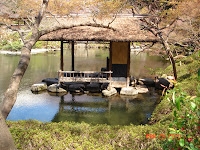












(PICTURES: 1-3: Our tour bus and view from the Tokyo Tower. 4-6: My finger appearing at the Happo-en Garden, other Garden pictures. 7-9: Traditional wedding and other beauties, all at the Four Seasons Tokyo Hotel at Chinzan-so. 10-12: Imperial Palace - Nijubashi Double Bridge, Security Post and Watchtower. 13-15: Senso-ji Buddhist Temple, fortune boxes, and incense pot. 16: Enchante, French Restaurant at the Da-Ichi Hotel
March 30: Ken and his family hooked me up with an 8 hour tour, to places I never knew about but would have wanted to see. It really gives a newbie like me a first-class look at Tokyo's main sightseeng spots. First, there's Tokyo Tower, which the guide says symbolizes Japan's recovery after the war, for many of its citizens. At night it lights up like a 333 meter high Christmas tree, and from the literature there is quite the popular hot spot for dancing. At the top-most floor, there is a glass tile in the floor that enables you to look all the way down. For people like me, standing on it for a quarter of a second gives you the hair-raising feeling that you are going to plummet to your death on the ground far, far below.
Next, and more to my interest, we go to the magnificent Happo-en garden to experience a traditional Japanese tea ceremony. I learn that this beautiful garden was once part of a daimyo's mansion (daimyos were the heads of powerful clans who controlled domains and provinces in medieval Japan) during the Edo period (1603-1867). I was already treated to a similar tea ceremony by Fumi-san, ten years ago when they came to visit Kentaro at my home, so I was familiar with the delicious deep green tea and the ritual of turning the bowl so that the decoration faces away from you as you drink. Before we left the gardens I got the chance to see a young couple in beautiful wedding dress, posing for pictures (the photographer waved me out of the way as I was blocking the background, but I got a couple shots), and also had a chance to view the interior of one of the incredible dining halls.
For lunch, where else but the incredible Four Seasons Hotel in Tokyo? I went to a Four Seasons once before, in San Diego for Berry Gordy's wedding in 1993. The Tokyo hotel kept up the fine tradition of knock-your-socks off ambience, in true Japanese style. After a delicious lunch prepared at our table (Japanese-style barbecue on a stone grill created from molten lava from none other than Mount Fuji), I got the chance to walk along the river, which was flush with cherry blossoms (sakura) in full bloom and lovely pink Japanese lanterns. Tokyo is a busy, bustling city, like New York. I would never have dreamed there was such a scenic garden spot in the middle of this city of over 12 million people!
After lunch, we headed for the Imperial Palace Nijubashi Bridge (we didn't go inside the palace because, as the tour guide explained, the Emperor hadn't invited us today). Again, right in the middle of big city Tokyo, is a huge estate surrounded by a moat, no less, where the Emperor lives. Outside, where we plebians were required to remain, there was Merry-Go-Round Park. I was on the prowl for a suitable souvenir keychain for a certain court clerk I know (and you know who you are, Perez!) who collects them. I couldn't get her just any one, so I was delighted to find one with a little wooden Japanese girl doll (there is a name for them but I forget) at a stand in view of the Gate of the Emperor's incredible estate.
After a quick stop at the moat, we drove past the Ginza shopping district, where I recognized local landmarks that I was familiar with (such as Gucci, Coach, and Hermes) on our way to the Imperial (Kaminarimon) Gate. Here, our tour guide advised us we would be able to get souvenirs galore. I was still on the lookout for a traditional Japanese kitty cat (aka Maneki Neko) keychain for Perez, so this was good news for me! Also, the guide recommended using the restrooms here as they were what she called "Western" style (little does she know that we Westerners don't really have the cool toilets with all the buttons, but those are the ones she meant). Traditional Japanese toilets are more primitive, of the "squat and aim" variety.
She also advised us how to ask where something was: For example, "Toilet do-ko?"
After a brief walk along the river, where the guide pointed out Sakura parties in progress (apparently during cherry blossom season, locals get saki and snacks and party down under the blooming cherry trees), the group split up to visit the 90 shops in the arcade leading up to the Imperial Gate and the Buddhist temple Senso-ji.
The shops were a bit much for me. I wasn't used to hundreds of people crammed together and bumping into each other, leaving only inches for each one to move. Besides, since I drink water constantly I have to go to the bathroom every 5 minutes. So after I had secured a Maneki Neko keychain for Perez, I tried to find the highly recommended Western style bathrooms.
Unfortunately, I didn't correctly remember the word for "Where." I thought our guide said "Do-koo?" (Which, I later learned, means "poison.") So I suppose I can't fault the owners of the coffee shop I ran into and urgently requested "Restroom, do-koo?" They gave me a puzzled look and said "Coffee?" I received similar responses to my inquiry from other shop owners. First, (I later learned) they have no idea a "restroom" is, and coupled with "poison" they probably just figured I was nuts.
In desperation I resorted to my map, and finally I was at least able to locate the traditional Japanese toilets. Which will work in a pinch.
It was nearing 5 and I was wearing out by this time, but determined not to quit until I saw it all. I trudged on to the Senso-ji temple. In front of the impressive edifice, I saw a lot of people burning incense, sticking it into a large pot and fanning the smoke towards themselves. Figuring it couldn't hurt, I joined them.
Inside the temple, there was a place where you could buy a fortune (not massive wealth; but a little paper telling you your future). By then I had found my original group, just in time to hear the tour guide explain that you could buy the fortune and if it was good, keep it. If it was bad, you tied it onto a series of wires and thereby avoided the bad luck. I noticed the massive amount of little papers tied to the wires, and decided not to buy a fortune. If I could get out of a bad one just by tying it to a wire and buying a new one until I got one that I liked, how providential could it be? Besides, I was wiped out and just wanted to get back to my hotel.
Some of us (including me) were dropped off in Ginza, to walk home from there. I would have liked to have taken the train, and just stood mindlessly until my stop. But without my host son Kentaro to read the signs for me, I was afraid I'd end up in Timbukto with no idea how to get back. I was too tired for such adventure, and a little sick as well.
Usually, being dropped off in the shopping district would be good news for someone like me, who enjoys stopping by the Coach store now and again. Fortunately, I did remember the way very well just from the familiar landmarks: There's the Kabuki Theater. There's Gucci, and Hermes, and there's Coach.
Being on holiday and thinking I might find something distinctly Japanese for myself or my daughter, I did stop at the Coach store (I might be tired but I'm still a woman!). But I was too exhausted to even look, let alone handle the over-zealous clerk who was determined to sell me something at all costs. So I explained I was under the weather and walked on to my hotel. Luckily, Kentaro and I had taken this way yesterday and I remembered the Peninsula Building he pointed out, my signpost for where I had to turn left to walk down the alley. Alleys in general are much safer to walk down in Japan, and I had a fairly long but unevent walk home, whereupon I collapsed in my room.
March 31: A free day for me, so I slept in, went back to the Ginza district to check out what I'd missed the day before. I asked Kentaro for a good Japanese stationery store, and he pointed me to Itoya, a very elegant, tiny-but-tall store in Ginze that was 9 stories high. No one understood what I meant by "stationery" so I was sent to almost every floor. Result - I got to see all the cool stuff they had, and finally even found stationery! In the evening, it was dinner and a glass of champagne at a nice French restaurant in the hotel. The restaurant was beautiful, and what was best for me is that it was blissfully empty, save two other tables. I sat in a dreamy daze, listening to Chopin and enjoying the peace.




No comments:
Post a Comment